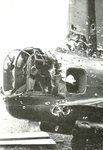Medvedya
Master Sergeant
cheddar cheese said:You say that when the rear turret is in full rotation, the door is pointing outside yes? Because this was how the gunner bailed out. Perhaps it was armoured so that when the turret was rotated around fully to say, the port side, it was designed to protect the gunner from enemy aircraft attacking from the starboard side?
Ah - I forgot to read this. No, that would have just been a bonus. The armoured doors behind the rear gunner are to stop bullets reaching the rest of the crew. Many a time did a Lanc get back with the rest of the crew all sitting ashen-faced up front, and the poor gunner smeared all over the perspex of his shattered turret.

